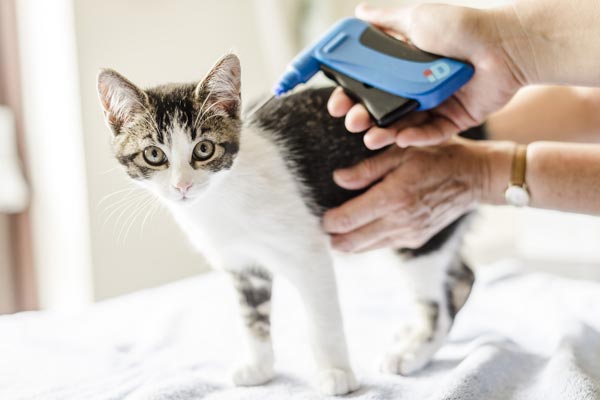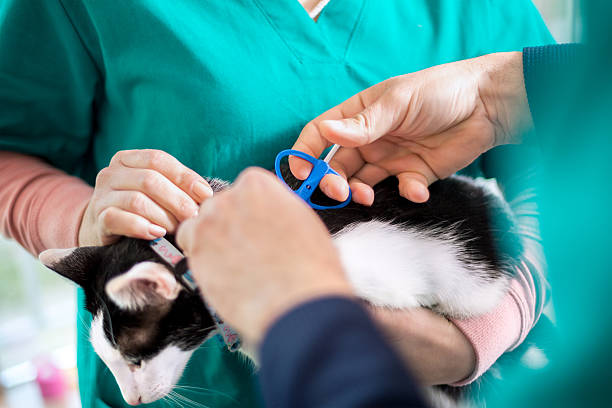Last Updated on February 21, 2024 by Fumipets
Unlocking the Mystery: How Much Does it Cost to Microchip a Dog?
Microchipping has become a standard practice in responsible pet ownership, providing a valuable tool for reuniting lost dogs with their owners. While the benefits are evident, many pet owners wonder about the financial aspect of this procedure.
In this exploration, we delve into the question, “How much does it cost to microchip a dog?” to shed light on the expenses associated with ensuring your furry friend’s safety and security.
Microchipping a Dog
Few things in life can make you feel as terrified and powerless as discovering your cat has gone missing. Unfortunately, many lost cats are never discovered, and they either die on the streets or languish in shelters.
However, there is one thing you can do to improve your chances of finding your cat alive: They’ve been microchipped. These small gadgets increase the chances of your cat being discovered and eventually reunited with you.
While this sounds great in principle, it also presents a few concerns.

What Is a Microchip and How Does It Work?
Microchips are tiny electronic devices that are placed just under the skin of your cat, typically between the shoulder blades.
A radio frequency (called an RFID) is included in the chip, and veterinarians and animal control officers have specific equipment that can read such frequencies. The reader will reveal the pet’s unique number after scanning the chip.
This number will be registered with the microchip manufacturer, which will also keep a record of your personal information. They will then call you to inform you of the whereabouts of your lost pet.
This guarantees that the microchip business is the only one who has access to your contact information – the person with the scanner will only be able to view your pet’s unique ID number, which is useless to them.
It’s important to note that you must register your cat’s microchip in order for the business to notify you when your pet is located. Many pets are microchipped, but their owners forget to register the chip with the business, making it impossible to reconnect missing dogs with their owners.

What is the best place to have my cat microchipped?
The majority of folks just have their veterinarians perform it; it’s a regular operation that doesn’t cost anything.
However, there are alternative possibilities. Many animal shelters will also do it, and some pet shops even have the capacity to implant a microchip (especially if you got your cat through them).
In the end, it doesn’t matter where you do it as long as you do it. The RFIDs that these devices transmit are global, which means that if one vet instals it, it can be read by another (or by an animal control worker, etc.).

How Much Does It Cost?
Depending on where you get it done, the cost may vary. However, if you get it done by a veterinarian, you can expect to spend between $40 and $50.
However, since the price for the clinic visit accounts for a significant part of that cost, getting your pet chipped at a routine checkup may save you money. It is generally free to register your chip with the business.
It’s possible that you may have it done for less money at an animal shelter or via a rescue organisation. Some shelters offer specific days when chipping prices are reduced, similar to a low-cost vaccination clinic. In such a scenario, you may be able to have it done for as low as $10.
If you get your cat from a shelter, he or she may already be chipped, so ask. The chipping may be done by the shelter (in which case it would be included in your adoption fee, although at a lesser cost than you’d receive from your vet) or by a former owner.
However, if the cat was previously chipped, you’ll need to contact the business to update your information. If your cat goes missing, you don’t want them to contact the previous owner.
Is Microchipping Painful for Cats?
It’s approximately as painful as getting blood taken, which means it’s unpleasant but not excruciating. Your cat shouldn’t have any problems with the implantation, and it shouldn’t have any long-term consequences.
If you’re concerned that your cat may be in discomfort, schedule the operation at the same time as another treatment, such as spaying or neutering. That way, the chip may be inserted when they’re asleep and they won’t be aware of it. This isn’t really required, but it might be a great addition.
One of the safest treatments you can do on a cat is microchipping. According to the American Veterinary Medical Association, the implantation technique has resulted in just 391 adverse responses, and over 4 million pets have been chipped.
The most frequent adverse effect is the chip moving away from its initial insertion location. This is unlikely to damage your cat, but it may decrease the odds of the chip being scanned if it becomes misplaced, so having your doctor check for the chip on a regular basis is recommended.
Hair loss, oedema, and infection are other possible adverse effects, but these are uncommon. Many people have heard that the chips cause cancers, however, only four out of four million chipped dogs have acquired tumours at or around the implantation site. That’s a very tiny percentage, and it’s quite conceivable that the tumours were produced by something completely unrelated.

Microchip Registry and Lookup
In the United States, there are many distinct microchip businesses, each with its own database. There is currently no central database in the United States that has information for all microchipped pets, although other nations (such as the United Kingdom) do.
Fortunately, when the chip is scanned, the name of the business is shown, so the vet will know who to call.
All of this will be for nothing until you register your chip with the appropriate company. Your vet (or whoever conducted the implantation) will give you documentation that explains how and where to register the chip once the operation is completed.
To avoid forgetting, we suggest registering it as soon as you arrive home. If you forget and your cat goes missing, don’t give up hope; if you have the papers, you may still register them.

Will a Microchip Help Me Track Down My Cat?
No, a microchip isn’t equipped with a GPS or other tracking device. It will only assist if your cat is discovered and sent to a veterinarian or shelter to be scanned.
As a result, using a microchip as part of a pet-recovery system is advised. Your cat should still be wearing a collar and tags, and you should make every effort to prevent them from escaping.
Collars with GPS trackers are available if you want to go the additional mile. They’re pricey, but they can help you find your missing cat with a high degree of precision.
They aren’t failsafe, and many of them will just give you a broad notion of where your cat is instead of directing you to their precise location.
Even so, if you apply all of these methods combined, you’ll have a better-than-average chance of finding your cat if they escape.

Conclusion
No one likes to think about their cat going missing, but it pays to be proactive if you want the greatest chance of reuniting with your best friend, and having them microchipped is a great way to do exactly that.
It won’t ensure that you’ll find your missing cat, but it will increase your chances!
Questions & Answers
Why is Microchipping Essential for Dogs?
Microchipping is a crucial step in ensuring the well-being of your canine companion. In the unfortunate event that your dog goes missing, a microchip serves as a permanent form of identification, increasing the chances of a swift reunion with their family. This simple procedure can be a lifeline for both pets and owners.
What Factors Influence the Cost of Microchipping?
The cost of microchipping can vary based on several factors. Location, the type of microchip used, and additional services offered by the veterinary clinic or animal shelter can all impact the overall expense. It’s essential to consider these factors when budgeting for this preventive measure.
Is Microchipping a One-Time Expense or a Recurring Cost?
Microchipping is typically a one-time expense. Once the microchip is implanted, it remains in place for the duration of the dog’s life. However, it’s crucial to keep the contact information associated with the microchip up-to-date to ensure its effectiveness in reuniting lost pets with their owners.
Are There Affordable Options for Microchipping?
Yes, there are affordable options for microchipping available. Many animal welfare organizations, clinics, and shelters offer low-cost or discounted microchipping services as part of their commitment to promoting responsible pet ownership. Researching local resources can help pet owners find cost-effective solutions.
What are the Potential Long-Term Savings Associated with Microchipping?
While the initial cost of microchipping may seem like an investment, the potential long-term savings can outweigh the expense. A microchipped dog stands a higher chance of being quickly identified and returned home if lost, potentially reducing the costs associated with prolonged searches or shelter fees.


















